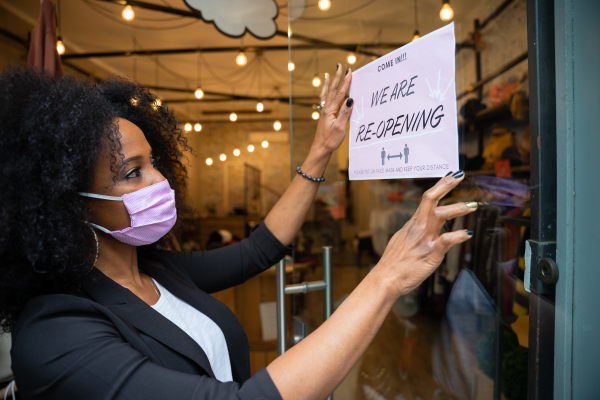Insights
INSIGHTS
All Topics
Is the charity sector burnt out?
07 Jul 2021by Laura Stanley
Burnout has become a watchword for much of the UK as COVID-19 persists. Here we examine how it is affecting the charity sector
When the UK first went into lockdown in March 2020, it was widely expected that it would be over within weeks. Even in June that year, Prime Minister Boris Johnson was promising the country it would see a return to normality by Christmas.
Now, halfway through 2021, with restrictions only just lifting, it appears few of us could have foreseen the situation we now find ourselves in, 18 months later.
For all the talk of ’the new normal’, it seems that change has been our only constant during this time. Within the space of a year, we have come to accept measures that might have previously been unthinkable as part of our daily lives, from social distancing to working remotely.
The situation continues to shift so rapidly that it can feel as though we’re on a train that never quite reaches its destination – and we’re hardly even sure where the destination is anymore.
With this continuous uncertainty in every aspect of our lives, coupled with disheartening news cycles and a distinct lack of human contact, it is little wonder that we find ourselves currently struggling with fatigue, anxiety, and a lack of motivation.
Put simply, the nation is burnt out.
What is burnout?
Burnout, according to mental health charity HelpGuide, is the “state of emotional, physical, and mental exhaustion caused by excessive and prolonged stress”. Those suffering from burnout may experience, among other things, feelings of irritability, disengagement, and increased cynicism. It can also manifest in physical symptoms, such as fatigue, headaches, and insomnia.
Burnout is far from a new concept – in 2018, The Guardian called it an “insidious epidemic” – but COVID-19 brought the matter to nationwide attention. Reports suggest that seven in ten workers in the UK experienced burnout in 2020, while a cross-party committee of MPs highlighted it as a significant risk to the NHS and care sector, with many employees quitting as a result of excessive workloads and pressure.
The change in working practices since the beginning of the pandemic has only added to this sense of malaise. In an intensely connected world, employees feel as though they are constantly ’on’, especially with the mass exodus from office spaces blurring the boundaries between our work and home lives.
Digital burnout has been a particularly difficult issue to contend with, with three quarters of adults saying they’d like a break from their digital devices. This would be hard before the pandemic, but as workplaces become increasingly virtual, taking a break from our screens feels nigh on impossible.
The UK Government has even considered following the example of its European counterparts and legislating against out-of-hours work emails in the UK to improve the work/life balance of employees.
Without a commute to mark the difference between work and home, employees have struggled to draw a line between the two.
How is burnout affecting the charity sector?
Charities, in particular, are feeling burnt out. A combination of constantly changing goalposts and increased demands on services, as well as concerns over funding and finances, has meant that working through the pandemic has often felt like fighting an uphill battle.
The charity sector has been among the most adaptable throughout the health crisis. The sector has had to learn new skills rapidly – still one in three charities had to cancel services amid the pandemic due to lack of digital knowledge – and deliver extra help to areas where it is most needed, even while bracing themselves for a downturn in monetary donations.
Indeed, as demand for services increased amid the health crisis, a loss of funding was cited as the biggest risk factor for charities by the Charity Risk Barometer, with some fearing their organisation wouldn’t be able to survive it.
With 44% of charities also identifying burnout as a significant risk to their operations, it’s clear that the sector needs support, now more than ever.
What can be done to deal with burnout?
While there is no quick fix for tackling burnout, the good news is that help is out there. Many charities have already put sustainable processes in place to support employees, with three quarters of charities offering flexible working arrangements, and 46% providing counselling services. More than half also say they have a wellbeing policy in place.
There are many external resources that can help us cope with stress and burnout too. Mental health charity Mind prescribes self-care measures such as making time for activities we enjoy, taking a step back from our screens before bedtime, and, importantly, ensuring that everyone takes their recommended breaks from work, including annual leave.
Mind also offers guides on how to ask for help at work, including advice on how to talk to management and leadership teams about mental health.
Looking forward
The pandemic has shed light on the many ways we can look after each other, whether donating time or money to good causes or simply checking in with a friend. The charity sector has been so used to firefighting throughout the health crisis to help those most in need, that the ability to look beyond it can feel overwhelming.
But, as restrictions lift and successful vaccination programmes give hope for a return to normality, organisations can begin to lend thought to their long-term solutions and take the time to assess their situation as it stands, including the needs of their employees. Charity workers have carried the candle too far to let the flame burn out now.
Laura Stanley
More on this topic
Related Content
Recommended Products
Featured Products
03 Jan 2025by Ioan Marc Jones
The best UK charity text donation services
12 Aug 2024by Christine Chiu
Top ten virtual fundraising event ideas for charitiesSponsored Article
Our Events
Charity Digital Academy
Our courses aim, in just three hours, to enhance soft skills and hard skills, boost your knowledge of finance and artificial intelligence, and supercharge your digital capabilities. Check out some of the incredible options by clicking here.
















